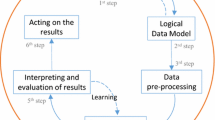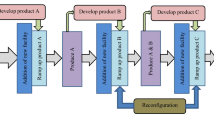Abstract
In today’s competitive market, manufacturers need to quickly adapt to the changing demands of the customers. Reconfigurable manufacturing system (RMS) is a cost-effective system that can easily absorb frequent changes in product demands. In this article such a system is modelled using expert enhanced coloured fuzzy Petri net (EECFPN), which considers the demands of customers as a fuzzy parameter and vividly captures the reconfigurability aspect of RMS. A fuzzy control strategy (FCS) is proposed to deal with the information delays occurring during information transfer or decision implementation. After intensive computational experimentation, it has been found that FCS outperforms the alternative priority (AP) heuristic and it is considered an effective measure to deal with situations where considerable information delay is involved.
Similar content being viewed by others
References
Moore KE, Gupta SM (1996) Petri net model of flexible and automated manufacturing systems: a survey. Int J Prod Res 34:3001–3035
Viswanandham N, Narahari Y (1994) Performance of automated manufacturing systems. Prentice-Hall, Englewood Cliffs, NJ
Lacksonen TA, Hong CY (1998) Project scheduling algorithm for re-layout project. IIE Trans 30:91–99
Yang T, Peters BA (1998) Flexible machine layout design for dynamic and uncertain production environments. Eur J Oper Res 108:49–64
Kochhar JS, Heragu SS (1999) Facility layout design in a changing environment. Int J Prod Res 37:2429–2446
Xiaobo Z, Jiancai W, Zhenbi L (2000a) A stochastic model of a reconfigurable manufacturing system part 1: a framework. Int J Prod Res 38:2273–2285
Xiaobo Z, Jiancai W, Zhenbi L (2000b) A stochastic model of a reconfigurable manufacturing system part 2: optimal configurations. Int J Prod Res 38:2829–2842
Xiaobo Z, Jiancai W, Zhenbi L (2001) A stochastic model of a reconfigurable manufacturing system part 3: optimal selection policy. Int J Prod Res 39:747–758
Liles DH, Huff BL (1990) A computer based production scheduling architecture suitable for driving a reconfigurable manufacturing system. Comput Ind Eng 19:1–5
Makino H, Aria T (1994) New developments in assembly systems. Ann CIRP 42:501–522
Rheault M, Drolet JR, Abdulnour GM (1995) Physically reconfigurable cells: a dynamic model for a highly dynamic environment. Comput Ind Eng 29:221–225
Aroson RB (1997) Operation plug-and-play is on the way. Manuf Eng 108–112
Lee GH (1997) Reconfigurability consideration design of components and manufacturing systems. Int J Adv Manuf Technol 13:376–386
Koren Y, Heisen U, Jovane F, Moriwaki T, Pritschow G, Ulsoy G, Van Brussel H (1999) Reconfigurable manufacturing systems. Ann CIRP 48:1–14
Kosko B (1992) Neural networks and fuzzy systems: a dynamical systems approach to machine intelligence. Prentice-Hall, Englewood Cliffs, NJ
Patil S (1971) Limitation and capabilities of Dijksta’s semaphore primitives for coordination among processes. MIT project MAC computation Structure Group Memo 57, MIT, Cambridge, MA
Agerwala T, Flynn M (1973) Comments on capabilities, limitations and correctness of Petri nets. Proceedings of the 1st Annual Symposium on Computer Architectures ACM, pp 81–86
Peterson JL (1981) Petri net theory and the modelling of systems. Prentice-Hall, Englewood Cliffs, NJ
Conway RW, Maxwell WL, Miller LW (1967) Theory of scheduling. Addison-Wesley, Reading, MA
Caprihan R, Kumar S, Wadhwa S (1997) Fuzzy systems for control of flexible machines operating under information delays. Int J Prod Res 5:1331–1348
Yu L, Shih HM, Sekiguchi T (1999) Fuzzy inference-based multiple criteria FMS scheduling. Int J Prod Res 37:2315–2333
Desrochers AA (1990) Modelling and control of automated manufacturing systems. IEEE Computer Society, Washington, DC
Pegden CD, Shanon RP, Sadowski RP (1990) Introduction to simulation using SIMIAN. McGraw-Hill, New York
Author information
Authors and Affiliations
Corresponding author
Rights and permissions
About this article
Cite this article
Kumar, R., Kumar, S. & Tiwari, M. An expert enhanced coloured fuzzy Petri net approach to reconfigurable manufacturing systems involving information delays. Int J Adv Manuf Technol 26, 922–933 (2005). https://doi.org/10.1007/s00170-003-1890-9
Received:
Accepted:
Published:
Issue Date:
DOI: https://doi.org/10.1007/s00170-003-1890-9




